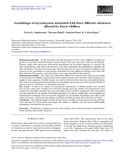Mostrar el registro sencillo del ítem
Assemblages of myxomycetes associated with three different substrates affected by forest wildfires
| dc.creator | Stephenson, Steven L. | |
| dc.creator | Payal, Nazrana | |
| dc.creator | Kaur, Gurpreet | |
| dc.creator | Rojas Alvarado, Carlos Alonso | |
| dc.date.accessioned | 2021-03-23T20:46:35Z | |
| dc.date.available | 2021-03-23T20:46:35Z | |
| dc.date.issued | 2021-03-23 | |
| dc.identifier.citation | https://www.plecevo.eu/index.php/plecevo/article/view/1755 | |
| dc.identifier.issn | 2032-3921 | |
| dc.identifier.uri | https://hdl.handle.net/10669/83128 | |
| dc.description.abstract | Background and aims – In late November and early December of 2016, forest wildfires occurred over portions of the Great Smoky Mountains National Park (USA) and more than 4 000 ha were affected. Previous studies have shown that myxomycete assemblages can be greatly impacted as a result of this type of disturbance; after which, the recovery of the forest determines the availability of substrates for new colonisation. The objective of the project reported herein was to assess the impact of wildfires on the recovery of the assemblages of myxomycetes associated with three different substrates (forest floor leaf litter, the bark of living trees, and woody twigs) in two areas with different fire intensity. Material and methods – Two study areas subjected to different fire intensity were selected and sampled 30 months after the wildfires. Myxomycetes were studied using the moist chamber culture technique as it applies to these organisms. Satellite imagery was used to determine forest recovery and similarity indices were used to compare experimental myxomycete assemblages among study areas and substrates. Historical data were used as a reference to contextualise the results. Key results – A total of 38 species of myxomycetes representing 17 different genera were recorded from the two study areas. Samples from the lower intensity burn area yielded more myxomycetes than samples from the higher intensity burn area, with values of 84% and 59%, respectively. This same pattern was also observed for the number of recorded specimens (133 and 93, respectively). The comparison of experimental assemblages with previous data suggested that ground litter assemblages were still in early stages of recovery, whereas the assemblages associated with bark and twigs had recovered much faster. Conclusion – The relatively higher intensity fire had more of an effect on myxomycetes than the relatively lower intensity fire. Myxomycete assemblages are resilient to wildfires and they recover differentially depending on the substrate they grow on. | es_ES |
| dc.description.sponsorship | Slime Mold Project at the University of Arkansas | es_ES |
| dc.description.sponsorship | Discover Life in America | es_ES |
| dc.description.sponsorship | Universidad de Costa Rica /[731-B7-721]/UCR/Costa Rica | es_ES |
| dc.language.iso | eng | es_ES |
| dc.source | Plant Ecology and Evolution 154 (1): 15–27 | es_ES |
| dc.subject | Disturbance | es_ES |
| dc.subject | ecological recovery | es_ES |
| dc.subject | forest ecology | es_ES |
| dc.subject | Great Smoky Mountains National Park | es_ES |
| dc.subject | North Carolina | es_ES |
| dc.subject | slime molds | es_ES |
| dc.subject | Tennessee | es_ES |
| dc.title | Assemblages of myxomycetes associated with three different substrates affected by forest wildfires | es_ES |
| dc.type | artículo original | |
| dc.identifier.doi | 10.5091/plecevo.2021.1762 | |
| dc.description.procedence | UCR::Vicerrectoría de Investigación::Unidades de Investigación::Ingeniería::Instituto Investigaciones en Ingeniería (INII) | es_ES |
| dc.description.procedence | UCR::Vicerrectoría de Docencia::Ingeniería::Facultad de Ingeniería::Escuela de Ingeniería de Biosistemas | es_ES |
| dc.identifier.codproyecto | 731-B7-721 |
Ficheros en el ítem
Este ítem aparece en la(s) siguiente(s) colección(ones)
-
Biología [1644]


